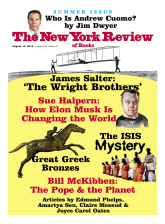In response to:
Two Cheers for the Middle Ages! from the July 9, 2015 issue
To the Editors:
I would like to clarify two mistaken impressions that might arise from Eric Christiansen’s review of my book, Dark Mirror: The Medieval Origins of Anti-Jewish Iconography [NYR, July 9]. Professor Christiansen writes, “Jeering Jewish onlookers as in the Quentin Matsys Ecce Homo…we are assured, were not intended to rouse hatred of living Jews or wound their feelings.” This implies that I deny the anti-Jewish nature of such images. I do not. By 1400 art viewers would certainly identify such figures as Jewish, and see them as villainous. I do maintain that the primary motivation for creating religious art was not to vilify Jews, and that it is worth asking when, how, and why nasty images of Jews became so central to Christian worship.
In reference to Cruikshank’s engraving of Fagin, Professor Christiansen writes, “There is no reason to suppose that Dickens and Cruikshank were any less pure in their intentions than were the twelfth- and thirteenth-century scribes, and yet it would be a naive apologist who explained the Hebraic Fagin as merely a moral fiction….” This could lead readers to assume that because I read some medieval images of Jews as being equally critical of Christian sin, I would attribute the same ambiguity of meaning to modern anti-Jewish caricature.
By no means. In history, chronology matters. Nineteenth-century anti-Jewish caricatures were drawing on—and their viewers’ responses were shaped by—a six-hundred-year-old-tradition of portraying Jews with certain negative features, postures, and symbols. In the thirteenth century, when Jews were first depicted this way, no such tradition yet existed. Unless we assume that (1) all or most Jews looked like their caricatures, and (2) the goal of medieval artists was to accurately portray Jews—neither of which is the case—we must ask what inspired the creation of such images, and what influenced their interpretation. And most importantly, how the development of medieval anti-Jewish iconography affected the way people viewed Jews, and so helped plant the seeds of Western anti-Semitism. Those are the questions I explore in Dark Mirror.
Professor Christiansen expresses doubt regarding whether hats served to identify Jews in high medieval art. I would refer readers to the many contemporary Christian texts cited in my book that associate Jews with pointed hats, or to any modern handbook of medieval iconography. I am glad to fully concede the similarity of the hats of Mexican peons to those depicted on some biblical Hebrews, but I confess myself baffled as to its relevance.
Sara Lipton
Associate Professor
History Department
State University of New York at Stony Brook
Stony Brook, New York



